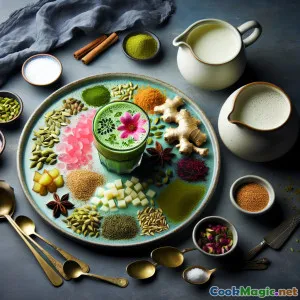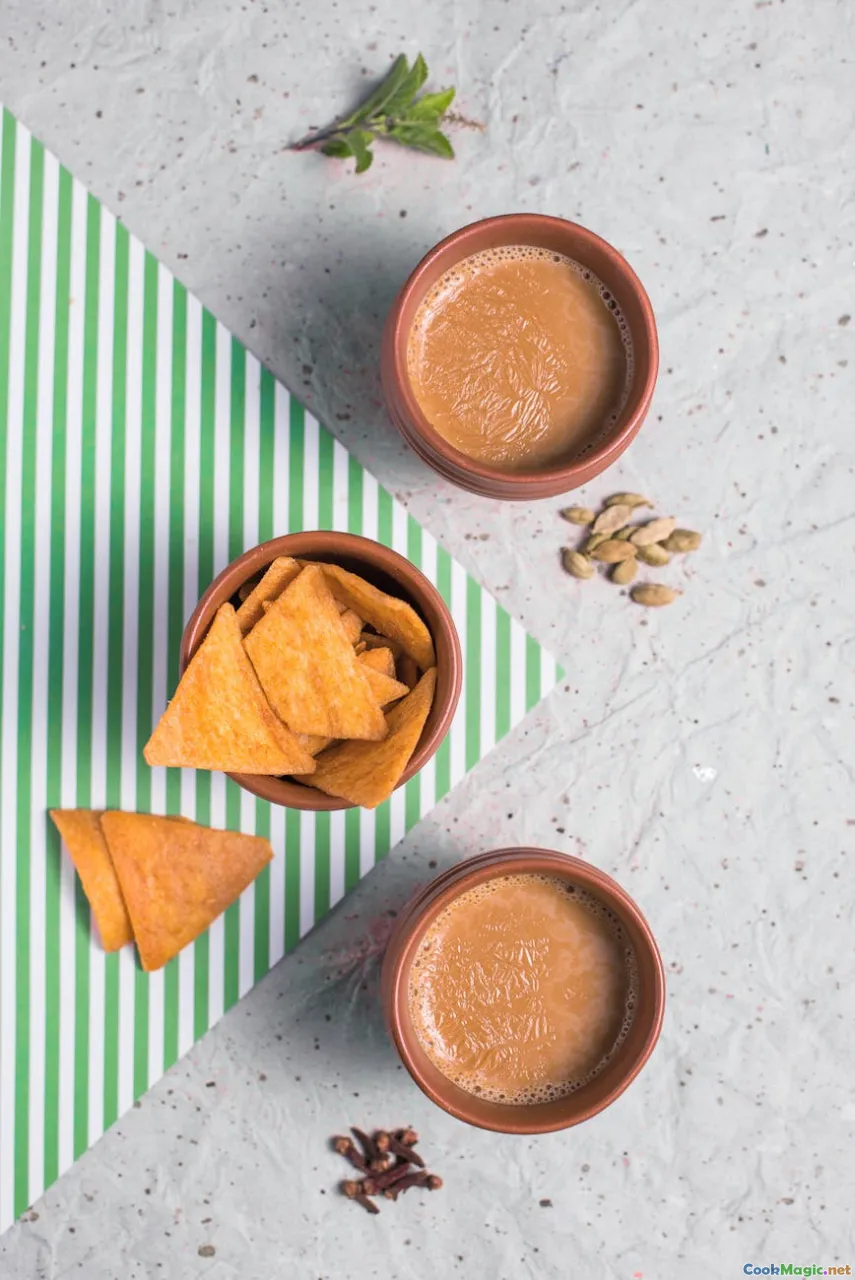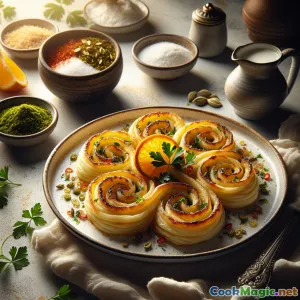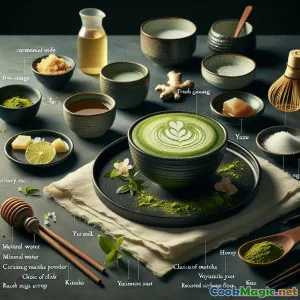
Meethi Chai Delight: Tè al latte dolce con cardamomo e zafferano
(Meethi Chai Delight: Cardamom-Saffron Sweet Milk Tea)
(0 Recensioni)0
184
ottobre 16, 2025
Segnala un problema
Ingredienti
-
240 ml Acqua
(Filtered for best taste)
-
300 ml Latte intero
(For richer body; use 2% for lighter)
-
2 tsp Tè nero Assam CTC
(Crush-Tear-Curl for strong brew; loose leaf acceptable)
-
3 tbsp Zucchero semolato
(Adjust to taste; can substitute jaggery)
-
3 pods Baccelli di cardamomo verde
(Leggermente schiacciato per rilasciare l'aroma)
-
10 grams Zenzero fresco
(Thinly sliced; warms and brightens)
-
0.5 tsp Semi di finocchio
(Adds a gentle licorice sweetness)
-
8 strands Fili di zafferano
(Bloom in hot liquid for color and aroma)
-
0.25 tsp Acqua di rose
(For a floral finish; add off heat)
-
1 pinch Pizzico di Sale
(Enhances sweetness without tasting salty)
-
2 tsp Pistacchi tritati
(Per guarnizione e consistenza)
(Filtered for best taste)
(For richer body; use 2% for lighter)
(Crush-Tear-Curl for strong brew; loose leaf acceptable)
(Adjust to taste; can substitute jaggery)
(Leggermente schiacciato per rilasciare l'aroma)
(Thinly sliced; warms and brightens)
(Adds a gentle licorice sweetness)
(Bloom in hot liquid for color and aroma)
(For a floral finish; add off heat)
(Enhances sweetness without tasting salty)
(Per guarnizione e consistenza)
Nutrizione
- Porzioni: 2
- Dimensione Porzione: 1 mug (240 ml)
- Calories: 360 kcal
- Carbohydrates: 0 g
- Protein: 10 g
- Fat: 10 g
- Fiber: 1 g
- Sugar: 44 g
- Sodium: 140 mg
- Cholesterol: 35 mg
- Calcium: 350 mg
- Iron: 1.2 mg
Istruzioni
-
1 - Bruise and Bloom Spices:
Lightly crush the cardamom pods with the side of a knife. If using saffron, set aside to bloom later. Slice the ginger thinly to maximize surface area.
-
2 - Start the Base:
In a small saucepan, bring water to a lively simmer. Add ginger, bruised cardamom, and fennel seeds if using. Simmer to perfume the water.
-
3 - Add Tea Leaves:
Stir in CTC Assam tea. Let it bubble for 30–45 seconds until the water deepens to a mahogany hue and the aroma turns malty.
-
4 - Milk In, Gentle Simmer:
Pour in milk. Reduce heat to medium-low and let the chai rise and settle twice, stirring to prevent scorching. Watch closely to avoid boiling over.
-
5 - Sweeten and balance:
Add sugar and a small pinch of salt. Stir until fully dissolved. If using saffron, crumble strands between fingers and stir in now to bloom in heat.
-
6 - Finish and Fragrance:
Turn off heat. Add rose water if using. Let the chai rest for 30–60 seconds to meld flavors.
-
7 - Strain and Serve:
Strain into warm mugs. Garnish with crushed pistachios if desired. Sip hot for the fullest spice bouquet.
Lightly crush the cardamom pods with the side of a knife. If using saffron, set aside to bloom later. Slice the ginger thinly to maximize surface area.
In a small saucepan, bring water to a lively simmer. Add ginger, bruised cardamom, and fennel seeds if using. Simmer to perfume the water.
Stir in CTC Assam tea. Let it bubble for 30–45 seconds until the water deepens to a mahogany hue and the aroma turns malty.
Pour in milk. Reduce heat to medium-low and let the chai rise and settle twice, stirring to prevent scorching. Watch closely to avoid boiling over.
Add sugar and a small pinch of salt. Stir until fully dissolved. If using saffron, crumble strands between fingers and stir in now to bloom in heat.
Turn off heat. Add rose water if using. Let the chai rest for 30–60 seconds to meld flavors.
Strain into warm mugs. Garnish with crushed pistachios if desired. Sip hot for the fullest spice bouquet.
Ulteriori informazioni su: Meethi Chai Delight: Tè al latte dolce con cardamomo e zafferano
Overview
Meethi Chai Delight is a celebration of sweetness, warmth, and the comforting rhythm of an Indian tea stall. Meethi means sweet, and this recipe leans into that promise with a balanced sweetness complemented by malty Assam tea, perfumed cardamom, and a whisper of saffron. It is the kind of cup that feels like a gentle hug on a breezy evening, or a joyful toast during festive gatherings. The method follows a classic Indian stovetop approach: bloom spices in water, extract the tea’s strength, then round everything with milk and sugar for a velvety finish.
What Makes This Recipe Unique
- Cardamom-forward profile: Many chai blends use complex masala. This one highlights the elegant partnership of cardamom and ginger, giving sweetness more room to shine.
- Saffron accent: Optional strands add golden color and a luxurious aroma without overpowering the tea. It’s a subtle flourish that elevates a homestyle cup into a celebration.
- Pinch-of-salt trick: A tiny pinch of salt amplifies sweetness, allowing you to use slightly less sugar while achieving the same indulgent taste.
- Rose-kissed finish: A drop of rose water turns the aroma into a soft, lingering bouquet — evocative of mithai shops and wedding feasts.
Tips and Notes
- Milk matters: Whole milk builds body and a creamy mouthfeel. For a lighter cup, use 2% milk; for dairy-free, try oat milk for silkiness or almond milk for a lighter finish. Coconut milk adds richness but can dominate the flavor.
- Watch the rise: Chai loves to rise dramatically. Let it climb and settle two or three times, reducing heat as needed. This technique aerates the tea and enhances texture.
- Saffron use: Crush strands between your fingers over the steaming chai so the natural moisture helps bloom the color and fragrance instantly.
- Sweeteners: Granulated sugar gives a clean sweetness. Jaggery (gur) brings mineral depth and caramel notes — add off heat and stir well to dissolve.
- Straining: A fine-mesh strainer ensures a silky sip. If you prefer rustic texture, use a tea strainer with slightly larger holes to let a hint of spice dust through.
- Make-ahead concentrate: Simmer the water with spices and tea for 3–4 minutes to create a strong concentrate. Refrigerate up to 2 days. To serve, reheat with milk and sweeten fresh.
- Iced version: Brew stronger by 25%, cool quickly, then pour over ice. Sweeten while warm so sugars dissolve, and finish with a splash of cold milk.
Cultural Context and History
Chai as we know it today is a relatively recent evolution in India’s long tea story. While tea plants are indigenous to Assam, widespread tea drinking was catalyzed during the British colonial period, when robust CTC (Crush-Tear-Curl) tea production took hold. Indian tea sellers — the famed chaiwalas — developed a distinctive preparation: strong tea boiled with milk, sweetener, and spices. This technique transformed a simple infusion into a layered beverage suited to bustling streets, train platforms, and home kitchens alike.
Meethi chai, specifically, is less about the full masala medley and more about an unashamedly sweet, smooth cup. It channels the everyday ritual of dipping biscuits, sharing gossip, and taking a restorative pause. In many households, a mid-afternoon meethi chai break is both a habit and a hospitality gesture, offered to guests as warmly as a smile.
Serving Suggestions
- Pair with crisp butter biscuits, jeera cookies, or rusk for dunking.
- Add a tiny sprinkle of pistachios or almonds for festive flair.
- For a monsoon treat, serve alongside pakoras or a simple potato puff.
- During holidays, pour into small kullad-style cups (unglazed clay) for an earthy aroma.
Troubleshooting
- Too bitter: Reduce the time the tea leaves boil before adding milk, or switch to a slightly lighter Assam blend. A touch more milk and sugar can rebalance.
- Not sweet enough: Add sugar in 1 teaspoon increments, stirring to dissolve fully. Remember that heat dulls sweetness perception; the cup will taste sweeter as it cools slightly.
- Boiling over: Use a larger saucepan and moderate heat. Stir and lift the pot briefly off the burner when the chai rises.
Personal Notes
I love that this recipe straddles everyday comfort and gentle luxury. The aroma of cardamom opening in hot water is instantly calming, and the saffron glow feels celebratory even on an ordinary day. It is a drink that invites you to slow down — to listen to the tiny sounds of simmering milk, to savor the steam, and to linger over conversation. Whether you take it street-style in a sturdy glass or in a favorite mug at your desk, Meethi Chai Delight turns a simple pause into a small, sweet ritual.























